
Homeopathy has long stood as one of the most fascinating—and often misunderstood—approaches to holistic health and wellbeing. Often seen as a fringe alternative to conventional medicine, this healing art has nevertheless garnered a loyal following among individuals seeking gentler, more intuitive means of addressing both chronic and acute ailments. A recent spike in public interest, sparked in part by the full-length documentary “Homeopathy - The Mystery of Healing,” has prompted a renewed discussion around the practice’s efficacy and place in modern living.
For UK-based homeowners, DIY enthusiasts, architects, and tradespeople, this resurgence in homeopathy offers a unique lens through which to evaluate not only personal health, but also the overall wellness atmosphere of the spaces they live and work in. Could the principles of homeopathy go beyond medicine to influence approaches to lifestyle, space design, and wellbeing-focused home renovations? Let’s dive in.
What Is Homeopathy?
Homeopathy is a system of alternative medicine developed in the late 18th century by German physician Samuel Hahnemann. The core principle of homeopathy is “like cures like,” which means a substance that causes symptoms in a healthy person may, in extremely diluted amounts, cure similar symptoms in a sick person.
Practitioners of homeopathy prepare remedies through a process of serial dilution and succussion (vigorous shaking). The more a substance is diluted, the stronger its therapeutic effect is believed to be—a concept that contradicts conventional pharmacological wisdom. Yet this is precisely where homeopathy’s mystique lies. Unlike chemical medications that work through measurable doses, homeopathy aims to trigger the body’s own healing mechanisms using minute, energetically potent doses.
For those in trades or building professions, this philosophy may surprisingly echo with certain principles of sustainable building and design—a matter of using what’s necessary, minimizing harm, and respecting natural systems. Architects, in particular, can draw parallels to biophilic design and principles of minimalism when thinking about ‘energetic resonance’ in a space.
The documentary “Homeopathy - The Mystery of Healing” provides a compelling journey into the origins, evolution, and controversies surrounding this form of medicine, offering viewers a nuanced look at how it continues to persist in a high-tech, data-driven healthcare landscape.
Homeopathy and Holistic Living Spaces
More than just a medical practice, homeopathy encourages a broader lifestyle of balance, sensitivity, and awareness. For homeowners and those involved in residential design or renovation, these concepts can be integrated into how we build and organize our spaces.
Today, many UK homeowners are investing in wellness-oriented living environments. Air purification systems, non-toxic paint, organic building materials, and natural lighting are just a few of the growing trends. The philosophy behind these choices aligns closely with homeopathic principles—reducing harm, improving the body's ability to thrive naturally, and fostering harmony with the environment.
As designers and tradesmen continually innovate new ways to create health-oriented homes, the inspiration homeopathy offers is profound: facilitating wellbeing through intentional, low-impact interventions. Homeopathy’s focus on prevention over cure also mirrors the idea of building homes that promote long-term health instead of merely responding to problems after they occur.
Whether you're redesigning a flat in Bristol, developing properties in Manchester, or renovating period houses in London, the idea of subtle, energy-conscious design can differentiate your projects and align with a growing demand for wellness-based living solutions.
Investigating the Role of Skepticism and Science
Of course, homeopathy does not come without controversy. Many critics, including scientists and medical professionals, argue that the remedies contain no active substance and operate purely via placebo. The documentary doesn’t shy away from these discussions, offering voices from both skeptics and ardent supporters. This balanced perspective allows for more informed personal decisions about health and wellness.
For UK-based DIY enthusiasts and professionals who default to empirical, practical approaches in their work, homeopathy offers a chance to engage with less tangible—but equally human-centered—concepts. It also challenges us to consider the psychological impact of spaces we build. How do clients feel inside a newly designed home? What emotional and energetic responses are we designing for, and can these less-visible outcomes be part of project KPIs just like energy efficiency or square footage?
While you might use screwdrivers and saws on-site, there’s also real value in exploring how health philosophies, such as homeopathy, can push you to go beyond form and structure into truly nurturing environments.
Applying Healing Principles to Interior Design
Healing is not just about the body—it’s about the spaces where we reside, work, and rest. Borrowing principles from homeopathy, interior design strategies can subtly catalyse healing through colour, arrangement, material, and even scent. A room painted in calming cool tones, lit by natural daylight, and infused with essential oils serves not only aesthetic purposes but wellness-driven goals.
Those decorating their homes can draw inspiration from the gentleness and intentionality of homeopathy. When selecting materials, think of those that “resonate” with the human body: low-VOC paints, natural wood finishes, breathable cotton or wool textiles. By eliminating toxins and introducing more life-giving elements, you mirror the goals of homeopathic treatment—creating a nourishing micro-environment that supports well-being daily.
For designers and home improvers who enjoy pushing creative boundaries, the incorporation of healing principles in home layout and energy flow (via Feng Shui or biophilic strategies, for instance) can take a design from simply functional to truly transformational. Adding indoor plants, orienting furniture for flow, and curating sensory inputs like fragrance and light are all within easy reach—and deeply meaningful for clients.
Benefits of Homeopathy-Inspired Living for Homeowners in the UK
In the layered tapestry of UK homes—from pre-war terraces in Yorkshire to new builds in the London commuter belt—the idea of healing through environment is especially relevant. Here’s how adopting homeopathy-inspired strategies can support homeowners:
| Benefit | Description |
|---|---|
| Reduced Environmental Toxins | Use of natural materials and finishes that eliminate exposure to harmful chemicals often found in modern building supplies. |
| Mental and Emotional Wellbeing | Spaces designed with mindfulness and intention reduce stress, anxiety, and improve focus. |
| Improved Indoor Air Quality | By choosing holistic design elements, such as indoor plants and organic materials, you're enhancing the breathability of the home. |
| Holistic Comfort | Beyond temperature control, comfort expands to emotional safety and energy balance in the space. |
| Unique Property Appeal | Homes with wellness features command higher interest from modern, health-conscious buyers and renters across the UK. |
Conclusion: Merging Healing with Habitats
The “Homeopathy - The Mystery of Healing” documentary reawakens a timeless intrigue: how does healing really happen? For those of us immersed in home improvement, architecture, and design in the UK, it offers more than a dose of philosophical wonder. It urges us to reflect on how we can build better—not just stronger or smarter, but kinder.
By blending the gentle wisdom of homeopathy with cutting-edge renovation logic, we can create homes not only tailored to human needs but also supportive of human healing. Whether you’re painting a nursery, re-tiling a bathroom, or finalising plumbing blueprints, a connection to wellness principles makes your work significantly more meaningful.
In this journey of building, healing, and thriving—maybe the space you create will be the next home someone heals in.





